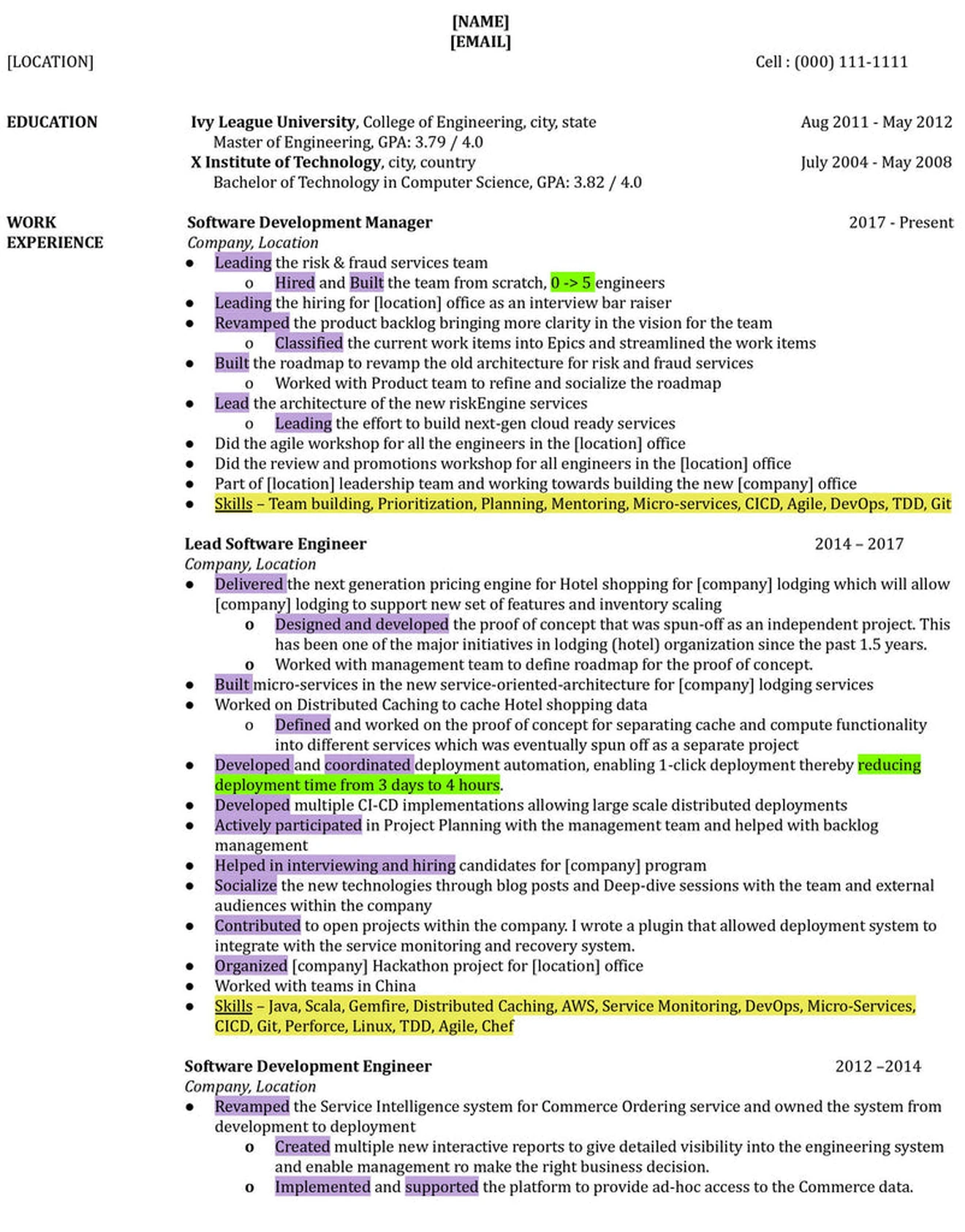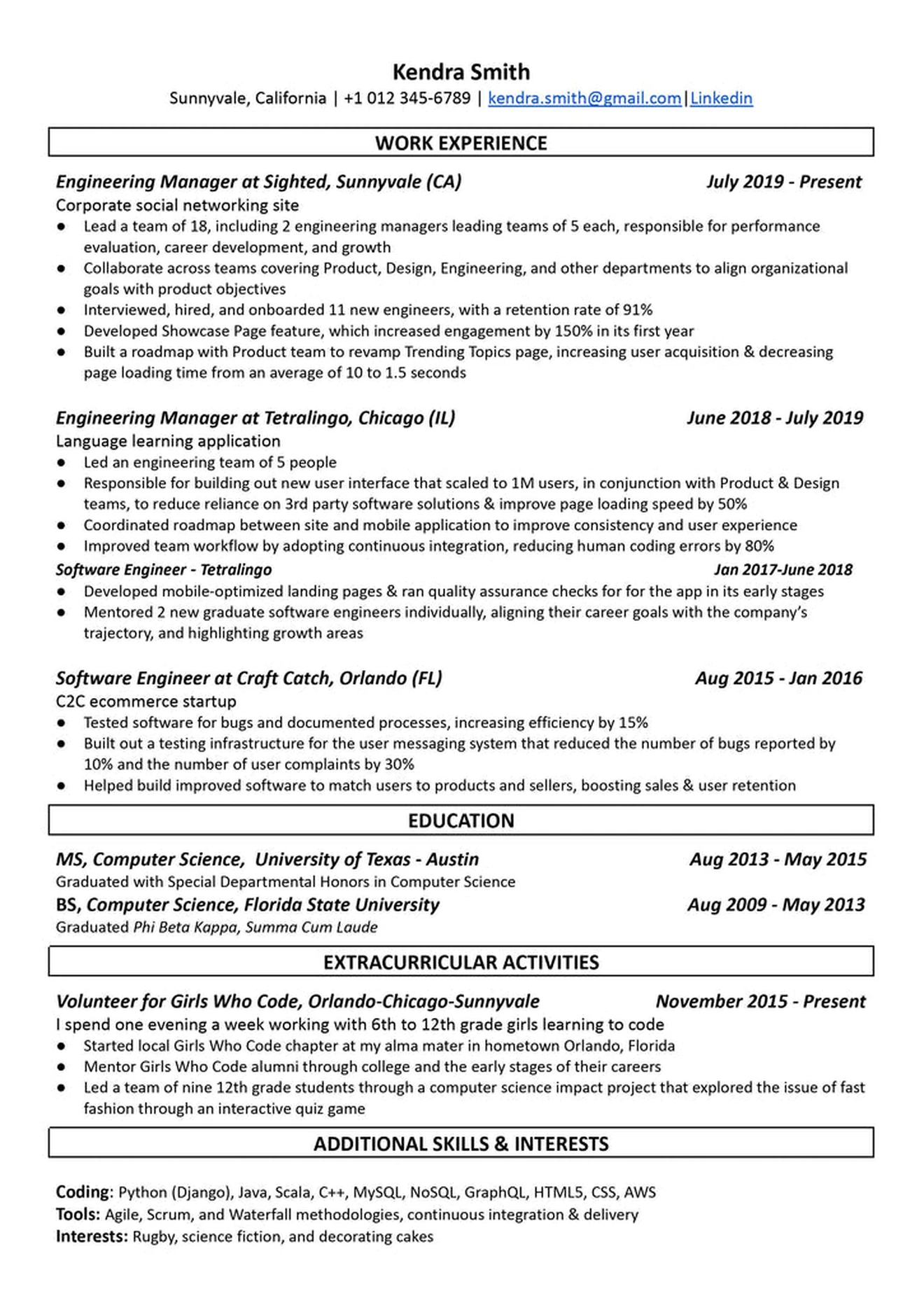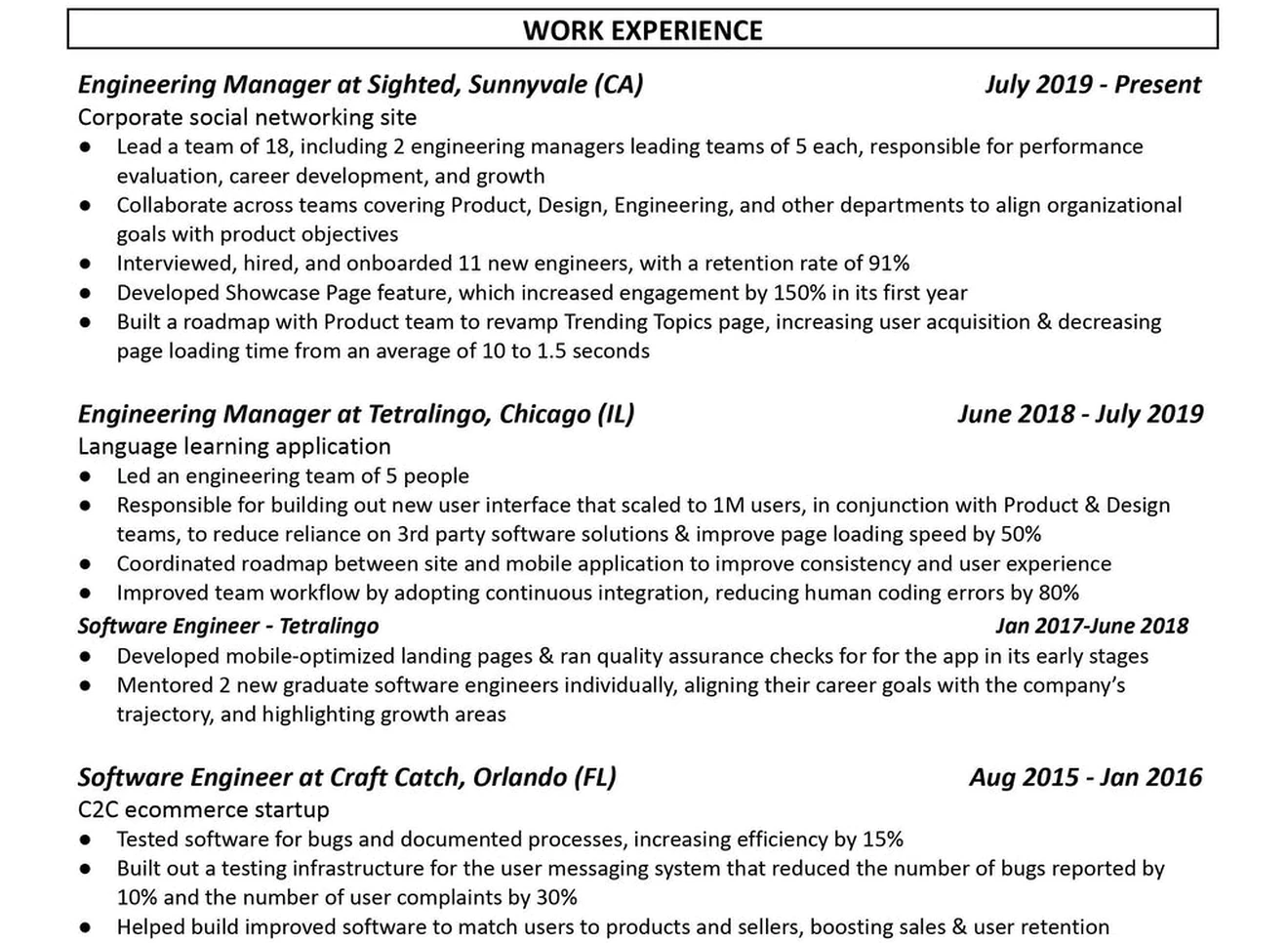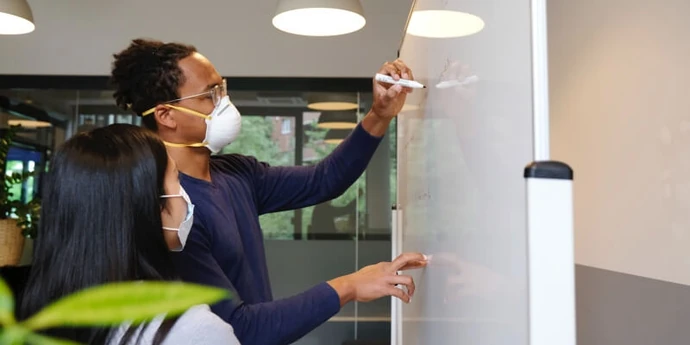Top tech companies receive millions of applicants per year, making acceptance rates for engineering managers and other positions at or under 1%. The majority of candidates don’t get past the resume screening.
To increase your chances of getting that EM interview, use our step-by-step guide to writing a top engineering manager manager resume.
As well as tips and expert insights from our resume coaches, it includes 5 EXAMPLES of resumes that worked for top companies like Meta and Amazon.
Yes, five actual resumes that real software engineering managers used to get offers (unlike the fake ones you find on the big resume sites).
Here’s an overview of what we’ll cover:
1. 7 skills for your engineering manager resume
2. Example resumes from REAL engineering managers
3. Engineering manager resume template (downloadable)
4. Engineering manager resume tips (from ex-Google recruiter)
5. How to write an engineering manager resume (section-by-section)
6. Your engineering manager resume checklist
Let’s get into it.
Get expert help on your resume from ex-FAANG engineering managers
1. Engineering manager skills for your resume
The job of an engineering manager is quite varied and broad, but we’ve identified several key skills that you’ll want to demonstrate in your resume to show recruiters that you’ve got what it takes.
Depending on what type of engineering manager you want your resume to portray you as, certain skill areas will be more important to include than others.
Take a look at the job description of the role that you’re applying for and make sure that you know which skills they are looking for in a candidate. Is the company looking for a software engineering manager, a partner engineering manager, a cloud engineering manager, or another specialty? In addition to the skills we'll mention below, you'll want to include ones relevant to the position itself.
Right, let's take a look at our list of EM skills. All engineering managers have a mix of technical (“hard”) skills and soft skills, so we’ll divide the important competencies into these two categories.
1.1 Technical ("hard") skills
Engineering manager recruiters are looking for candidates who have the technical skills to stay on top of and contribute to their team’s engineering work. The importance of technical skills varies depending which company you're applying to. At Meta it's less important, whereas at Google it's very necessary, as Mark told us.
"Google EMs candidates are expected to show they're used to getting hands-on (e.g. writing code, getting stuck in on designing architecture, being on-call)" Mark K, ex-Google EM.
Let's go into a bit more detail on the key technical skills at play here:
1. Coding skills to stay up to date with the engineering processes, coding languages, and methodologies that your team will be using to accomplish tasks and solve problems. So include past software engineering or other technical experience on your resume, as well as which coding languages you are proficient in, and what tools you use.
2. System design skills needed to design scalable systems that can stand up to high traffic. You’ll have to make decisions relating to efficiency, growth, and performance. So make sure that any experience you have in designing systems is prominent on your resume.
3. Data analysis skills to define success metrics and make sure goals are achieved. This means being comfortable using data to make crucial decisions in line with business objectives. You can demonstrate this in your resume by quantifying success on past projects in terms of key metrics.
1.2 Soft skills
In addition to hard skills, engineering managers need the soft skills to manage teams of software engineers and stay organized while juggling intricate projects.
1. Project management skills needed to execute complex, multi-disciplinary projects, from beginning to end. This is more of a wide-ranging skill set than one specific competency, so here are some of the most important components to cover in your resume: use of methodologies such as Agile, Waterfall, etc., prioritization, managing schedules and deadlines, allocating resources, and tracking and reporting progress.
2. People management skills in order to remove obstacles and enable your team to do their best work. Similar to project and program management, managing people requires a collection of skills, so here are the top ones that you should highlight: motivating a team, mentoring others, retaining direct reports, hiring well, and maintaining the organization’s company culture.
3. Leadership skills to drive projects forward and influence people even when you don’t have authority over them and when the right decision isn't necessarily obvious. Top companies don't want to have to tell you what to do; they want you to take ownership and get on with it.
"At Meta, there is an expectation that you will have a strong level of autonomy, ownership and dealing with ambiguity." Tom, ex-data engineering manager at Meta.
If you haven’t got many strong examples of leadership from your work experience, give evidence of leadership in the extracurricular section of your resume. You can also highlight related skills such as an ownership mentality, comfort with ambiguity, etc.
4. Cross-functional communication skills, to link engineering teams with product, design, and other divisions; to minimize conflict and miscommunication; and to keep stakeholders updated. While cross-functional communication is an aspect of a larger leadership skill set, we are setting it apart to highlight just how important it is for engineering managers.
Demonstrating these skills on your resume should signal to recruiters and interviewers that you have the capabilities they're looking for.
2. Software engineer manager example resumes ↑
Before we start guiding you on how to write your resume step-by-step, let's take a look at the kind of thing you should be aiming for.
You'll notice that the resumes don't fully follow the guidelines we set out in this article. We think this shows two things:
- there are many valid ways to write a resume
- your resume doesn't have to be perfect, as long as it demonstrates your skills and achievements effectively
Let's take a look. All the resumes below got real candidates job offers at big tech companies.
2.1 Meta engineering manager resume example
The resume below successfully got Dario (not his real name) into Meta, after he worked with coaches on our platform to ace the Meta EM interviews.

Here's our feedback on this resume:
- Highlights only: Every bullet point is impressive. Dario no doubt had plenty more achievements he could have included, but he cherry-picks the most impactful and packs them all into one page.
- Quantified impact: Dario uses numbers to clearly demonstrate the impact his actions had. He always uses at least one metric.
- Skills: Without taking up much space, Dario lists key EM skills and tools that he's experienced with, for the benefit of both recruiters and Applicant tracking systems.
- Action verbs: See how many of the top bullet points begin with "Launched". This helps Dario immediately convey that he played a key role in these big product launches. Elsewhere on the resume, he begins with other powerful verbs: "Grew", "Built", "Founded", "Reduced"."
- Consistent formatting: Dario doesn't try to do anything clever with the resume's design, but he makes sure the formatting is 100% consistent. The layout is simple and easy to read, and the use of green for the role titles works well.
2.2 Twitter/X.com engineering manager resume example
This is another real example from an engineering manager. The candidate used it to get an offer from Twitter, now "X.com".
Note that some details have been anonymized in order to protect the candidate's privacy.


The candidate communicates his work achievements in a way that is very clear to understand. He does this via:
Action verbs: the candidate starts each sentence with a powerful action verb that reflects key EM responsibilities and skill areas
Quantifying achievements: he provides metrics to make his achievements measurable and specific.
Evolution of skills: he lists the skills he used in each position, to show how he has evolved and which skills he has used most recently
2.3 Amazon software development manager resume example
Below is another resume that crossed our desks recently. It earned its owner, let's call her "K", interviews for an SDM role at Amazon.




Here's our feedback on this resume:
- Adapted for target company: K knew that her experience with AWS Cloud engineering would be important to Amazon and so she puts it right at the top.
- Tools & technologies: K demonstrates experience with a vast number of engineering technologies.
- Length: This is a 4-pager! She got the interview anyway, but K would have helped recruiters by cutting it to two pages.
2.4 Amazon software development manager resume (expert)
The resume below is also from an Amazon SDM who is also a interview and resume coach on our platform. It's not the resume that got him into Amazon, rather it's his current resume.




Here's what our coach, let's call him Amar, does well in this resume.
- Quantified impact: He gives specific numbers and metrics to clearly state the impact of his achievements.
- Clarity: Most of the bullet points are 1 line, maximum two. There is plenty of white space and it's extremely easy to read and understand.
- Open-source contributions: It's great to include these on a resume as it shows you're passionate about engineering and suggests a collaborative mindset.
2.5 Amazon software development manager resume example 2 (expert)
The resume below is another current resume (2024) from an Amazon software development manager.

3. Engineering manager resume template↑
We've also created our own resume template to illustrate our tips at each step of the writing process. Below you can download it as a Google doc if you want to write your own resume over the top of it.
Unlike the two resumes above, this resume is not a real one. Instead, it's an amalgamation of the many high-quality CVs that candidates have shared with us before going on to work at Google, Meta, and Amazon, etc

Click here to download this software engineering manager resume template as a PDF.
Click here to open this engineering manager resume template as a Google doc
4. Engineering manager resume tips ↑
Before we take you through the step-by-step process of writing your engineering manager resume, let's look over some key tips and insights that you'll want to keep in mind.
We asked Cody (top tech recruiter, ex-Google now at LinkedIn) what advice he'd give to someone writing a resume to get into FAANG or similar. This is what he came up with:
#Answer recruiters' questions immediately
There are two things that all recruiters and hiring managers want to know immediately: your years of engineering experience and years of management experience.
So, make it easy for them.
"Us recruiters are lazy. Don't make us dig around for the key info, we want to see if you meet the job requirements in the first 10 seconds!".
To do this, you could include some bullet points with this key information at the top of your resume. Which leads us to the next point...
#Consider a non-traditional format
The lay out we recommended in section 5 is the traditional one, perhaps the safest. But it's not obligatory. Cody prefers using two bullet-point summaries at the top of your resume to pack in the key information and your most impressive career achievements.
"The top of the resume is the prime real estate. Put the shiny bits, your best achievements, up top. That way you've got a better chance of grabbing the recruiter's attention."
This is what it looks like on his resume:

Watch Cody's full explanation of this non-traditional resume format.
# Include the location you’re open to working at / remote
If recruiters are going to approach you for roles, rather than the other way around, they'll need to know the locations you're available to work at.
If you're willing to relocate for the right role, make that clear in your resume. So, instead of putting "San Francisco" under your name next to your email, maybe you put "Locations: San Francisco| Remote| Hybrid within a 30-mile radius of Bay Area".
#Don't include your address
No recruiter needs to know your street address, and including it can actually cause problems with data privacy laws. As above, just put your region and an idea of where you're willing to travel to.
#Numbers tell a better story
This bears repeating again and again: quantify your achievements. All the most effective resumes are packed full of metrics and numbers that put achievements in context.
"Especially in engineering but honestly this advice is for many careers spanning many industries, we have to tell our story through data and numbers. Words can tell a story but numbers tell it way better" says Cody.
So, if you launched an app, say how many downloads it got. Or how many days ahead of schedule you launched. If you managed a team, say how many people were in it. Without numbers, your achievements are hard to evaluate.
#Avoid common pitfalls
Cody sat down and told us about the most common traps that people fall into with their tech resumes.
"I read tons of resumes each day, and the most common errors people make are being too vague about achievements, and not setting out the information clearly in a way that's easy for the recruiter to take in."
We recommend watching the conversation with Cody in full to make sure you're fully aware of what NOT to do:
5. How to write an engineering manager resume (section-by-section) ↑
Right, now we know what we're aiming for, let’s take the first step in building an engineering manager resume.
5.1 Step 1: Study the target company and job description
Before you start writing or editing your resume, our tip is that you do some research.
Find the job specification, read it thoroughly, and use it to shape your resume in the following ways:
- First of all, work out what type of engineering manager the job description is looking for. Which engineering management skills will be most crucial for the role? Prepare to adapt your resume’s content accordingly.
- Zoom in on a few of the responsibilities in the job description that you think are most important. Search for specific examples from your past that demonstrate experience in doing the same thing or something very similar. Find the numbers to back it up where possible, so you’re ready to include this information in the work experience section later on.
- Take note of the language used in the job description so you can, where appropriate, match specific verbs and phrases.
- Research the company. For example, imagine you’re targeting a software development manager role at Amazon. Amazon has 16 leadership principles, so you’d want to make sure that your resume transmits some of these values. That might mean highlighting when you’ve worked under budget to reflect “Frugality” or when you’ve taught yourself a skill for “Learn and Be Curious.” Do the same if you’re applying for Meta or Google.
Does all this mean you’ll need a different iteration of your resume for every engineering manager job you target? Ideally yes, but there will be a lot of overlap, so usually you’ll only need to make a few strategic edits.
Right, once you’ve done the research, you’ll be ready to start writing.
5.2 Step 2: Choose a layout
The design of your resume should have one objective: to convey as much information as possible in a way that is clear, easy to digest, and professional. Use our sample resume as your template, and you’ve already achieved that!
Some people add a second objective: to demonstrate strong design skills in order to stand out from the crowd and impress the recruiter.
However, we recommend treading carefully with this. Recruiters for large companies are unlikely to be impressed by a resume’s design; they’re interested in the content. Some might even be put off by a “creative” or unique design. To avoid this risk, aim to stand out through your resume’s content, not its design.
Another area of debate is length. Should you always stick to just one page?
The answer is no, not necessarily. It’s fine to go to two pages, as long as all the content you’re including is strong and relevant to the role. We can confirm this because many of the candidates who use our coaching service got their FAANG interviews using two-page resumes (such as the one in section 2).
However, if you’ve only been working for a few years, or you’ve recently graduated, we strongly recommend sticking to a single page.
5.2.1 Sections/categories
We recommend using the following section layout for an engineering manager resume. The exact titles and order of the sections is open to debate, but we know that this approach works for companies such as Google, Meta, and Amazon, for both junior and experienced candidates.
- Personal information
- Work experience
- Education
- Extracurricular
- Skills & Interests
Whether or not you stick exactly to our suggested categories, we highly recommend keeping these general layout/design tips in mind:
DO
- Choose a professional-looking font: Size 10-12, black and white. Arial and Calibri are fine
- Save it as a PDF
- Use bullet points
- Make sure the formatting is 100% neat and consistent
- Include enough white space that it doesn’t look overcrowded
DON’T
- Include a “summary” or “objective” section at the top (unless you have an unusual profile which needs explaining). Your resume is already a summary, so this just wastes space
- Include references
- Pick an unusual font to try and stand out
In the remaining steps, we’ll help you craft each section. Let’s go!
5.3 Step 3: the Personal Information section
This section is not the place to try and impress. Just make sure you get your details across in as few words as possible and avoid mistakes.

Notice how the above example is extremely clean and easy to read. Follow these tips to achieve the same:
DO:
- Use bigger font for your name than for the rest of the section to make it stand out
- Include your name, email address, phone number, city/county you live in
- Ideally include a link to your LinkedIn profile or Github
DON’T:
- Title this section. It’s not necessary in this type of layout, so save the space
- Include a street address, as it’s unnecessary and unsafe
- Include a photo, date of birth, or gender, unless specifically requested to do so
- Don’t label each piece of information e.g “email,” “tel,” etc. It’s obvious what they are, so save the space
- Link to personal or portfolio websites here, as you can do that lower down
5.4 Step 4: the Work Experience section
This is probably the most important part of your resume to get right, and the easiest to get wrong. Many candidates think that their work experience speaks for itself, and simply list their role and a few of their main responsibilities.
However, we recommend a much more powerful approach.
Instead of listing responsibilities, you need to talk about actions. This means starting each bullet point with an action verb. These verbs should relate to the seven skills from section 1 that companies look for in EM resumes (coding, system design, data analysis, project management, people management, leadership, communication). "Executed," “Built,” “Developed,” "Unblocked," "Led," and "Delivered" are some good examples of such verbs.
Choosing actions that are relevant to one of the seven engineering manager essential skills (and any others that you see listed in the job description) will also mean that your resume contains the keywords that recruiters (and sometimes Applicant Tracking Systems) will be looking for.
You should also focus on the results of what you did and quantify them as much as possible to highlight the tangible contributions you have made. Ex-Google SVP Lazlo Bock talks about a common method for doing this that you might find helpful, called the “X, Y, Z” formula.
Finally, balance is also important. Because an engineering manager role is quite multifaceted, it’s important to demonstrate a range of skills in the work experience section. Take a look at the example below and notice that as well as examples of software engineering, there are also examples of leadership, people management, volunteering, running projects, etc.

Ready to start writing this section? Use the tips below to keep you on the right track.
DO:
- Use reverse chronological order, putting most recent employment at the top
- Use present tense verbs (e.g. "Lead, Coordinate, Execute") in your current position (except for completed achievements), and past tense verbs for past positions (e.g. "Led, Coordinated, Executed")
- Describe your actions and what they achieved
- Include metrics to quantify what your actions achieved where possible
- Study the language of the job description and where appropriate, match it
- Make sure you’ve naturally included keywords relative to the job description
- Demonstrate a balance of skills
DON’T
- Be shy and humble. Now is not the time!
- Just put your responsibilities
- Be vague
- Go so overboard with numbers that it looks like a math problem. It still needs to be easy to read
- Include lots of buzzwords just for the sake of it
5.5 Step 5: The Education section
This section should be extremely concise and clear. Hopefully, your educational achievements can do the talking for you, as all you can really do here is present the necessary information with the right level of detail.
Let’s take a look at what it should look like.

Note that if you have recently graduated and only have internship experiences, this section should follow the Personal Information section, and you may want to go into a bit more detail. Otherwise, you can include it after work experience.
Follow the tips below to make sure you get it just right.
DO:
- If you have multiple degrees (e.g. a BS and a MS), you should write a subsection like the one above for each degree, starting with your highest level of education first (e.g. your MS)
- For each degree, include the name of the degree, university, and dates in the headline. If you’re a recent graduate you can also list any subjects you have taken that are relevant to engineering management (e.g. data structures, algorithms, systems, etc.)
- List your grades (e.g. GPA) as well as results of other standardized tests you have taken (e.g. SAT, GMAT, etc.) that demonstrate your intellect
- Detail any awards and scholarships you received at the university level and most importantly how competitive they were (e.g. two awards for 1,000 students)
DON’T:
- Panic if you don't have a degree. You don’t have to have gone to college to get into a FAANG company. Instead put your high school grades and any relevant educational qualifications you gained after school
- Include high school experience if you've already graduated
- Include your thesis/dissertation unless you're a fairly recent graduate, in which case you should summarize the topic in a way that's VERY easy to understand
5.6 Step 6: the Extracurricular Activities section
Engineering manager roles require a very large breadth of skills, and it can be difficult to demonstrate all of them through your work experience. The extracurricular section is therefore a great opportunity to cover these skills. It can be particularly useful in demonstrating leadership skills, especially if you haven’t yet had much opportunity to lead in a work situation.
Note: If you’re applying to Google, you should consider calling this section “Leadership & Awards” to fit in with their recommended resume structure. Obviously, you’ll need to make sure that the content demonstrates those two things.
Below is how this section looks on our example resume.

The extracurricular section is more important for recent graduates than experienced hires, but even for engineering managers with a lot of impressive work experience to fit in, leaving a bit of space to talk about your personal projects can add a whole new dimension to the “you” on your resume.
However, you simply might not have any recent and relevant extracurricular activities worth including. This is often the case for parents who have young children. If that’s the case, you can leave out this section and fill the space by adding more content to the work experience section. After all, if it’s not going to make you shine, there’s no point including it.
Ready to write the extracurricular section? Here are the remaining tips you need to know.
DO
- Use this section to demonstrate relevant skills, such as leadership
- As with work experience, try and include actions and achievements, and quantify them
DON’T
- Put a hyphen in the title: "Extracurricular” is all one word
- Capitalize “university” unless you’re using it as a proper noun (e.g “Oxford University”)
- Give very outdated examples. If you graduated seven+ years ago, there shouldn’t really be university examples there
5.7 Step 7: The Additional Skills & Interests section
Engineering managers need to be adept at using a wide range of tools, methodologies, and technologies, and this section gives you the opportunity to list yours.

Of course, you should list any programming languages (e.g. HTML, CSS, JS, Python, etc.), as well as relevant tools that you use in engineering or for project management. You can also list any foreign languages you speak, as employers generally look favorably on them.
Under “Interests,” listing a few hobbies is an opportunity to show some more of your personality and to stand out from the crowd.
However, if you feel you’ve already covered your personal interests in Extracurricular, (or if you’ve been so career-focused that you simply don’t have any!) then you can change this section to just “Additional skills.”
Additional tips:
DO
- List things in sentences rather than lots of bullets, which take up too much vertical space
DON’T
- Include generic, uninteresting things that everyone likes doing, like “watching Netflix” or “hanging out with friends,” as hobbies
5.8 Step 8: Proofreading and feedback
Attention to detail is a core engineering manager skill, so don’t skip this step! Use the grammar checking tool in Word or Google Docs, and proofread until it’s perfect. This is harder than it sounds because multiple reviews and tweaking after the initial proofread can easily create new hard-to-spot errors. The only solution is to proofread again.
We recommend saving it as a PDF file unless the job description says otherwise, and checking it opens properly (with the correct formatting) on a Mac or PC.
Receiving feedback is also important. Share it with a friend or partner, and they’ll be very likely to see mistakes that you haven’t noticed. Of course, if you can share it with an experienced engineering manager, that’s even better.
DO
- Proofread from top to bottom and then read it in reverse to check spelling
- If you’ve tweaked it, proofread again before sending
- Check the file opens properly on Mac and PC
- Get feedback on it before sending
DON’T
- Send it with typos. Your resume is your product!
6. Your engineering manager resume checklist ↑
Almost ready to send your resume? Use this checklist to make sure you’re following the best practices we’ve recommended above.
If you can answer “Yes” to every question, then you’re ready to send it.
General
- Does your resume fit the requirements of the job description?
Layout
- Is it just one page? If not, do you have the experience to merit 2 or 3 pages?
- Is the formatting 100% consistent and neat?
- Is there enough white space to breathe?
Personal Information
- Have you checked your contact details are correct?
- Have you included an idea of the locations/regions you're willing to travel to?
Work Experience
- Have you talked about your actions rather than your responsibilities?
- Have you quantified the impact of your actions?
- Have you demonstrated the seven EM skills? (coding, system design, data analysis, project management, people management, leadership, communication)
- Have you got the tenses correct?
Extracurricular
- If you graduated >5 years ago, are your examples post-university?
Skills & Interests
- Have you listed all the programming languages and tools you’re familiar with?
- Do your interests make you stand out from the crowd in some way?
Proofreading and feedback
- Have you proofread it since you last edited it?
- Have you received any feedback on your resume and updated it?
- Have you saved it as a PDF to make sure it displays correctly on all devices?
Did you say “Yes” to every question? Well done! If you’ve used all the tips in this article, then your resume should be in good condition and will give you a fighting chance of getting that interview.
7. Is your resume truly outstanding? ↑
If you're going for one of the top tech jobs, having a resume that's "fine" may not be enough. To get your engineering manager resume from "fine" to "outstanding" usually requires feedback from someone who really knows their stuff - as in an ex-recruiter or manager at one of the top companies.
We know it's hard to get access to those type of people. That's why we've created a resume review service, that allows you to get immediate feedback on your resume with a top recruiter/coach of your choosing. Take a look!















